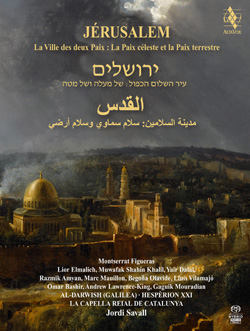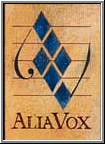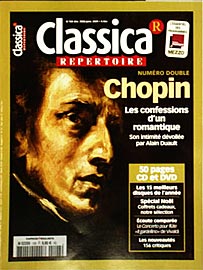|
Jérusalem
La ville des deux
paix -
City of the two peaces.
La Paix céleste et la Paix Terrestre
The music of the
history of Jerusalem |
|
Raices & Memoria, vol.
VIII
Racines & Mémoire, Roots & Memory, vol. VIII |
|
Alia Vox AVSA9863
Édition
originale/Original recording
Alia Vox SACD 9863 (A +
B) (Hybrid)
Code Barre : 76199886398631 |
|
|

Livre de 423 pages & 2 CD
(Français / Castellano / English / Català
/ Deutsch / Italiano
Raices & Memoria vol.
VIII
|
Description
Artistes / Performers :
La Capella
Reial de Catalunya
Al-Darwish (Galilea)
Hespèrion XXI
Montserrat Figueras
Direction : Jordi Savall
Lieux d'enregistrement / Recording sites:
Collégiale de Cardona
(Catalogne). L’église de Saint-Pierre-aux-Nonnains. L’Arsenal de Metz
L’Abbaye
de Fontfroide
Dates d'enregistrement:
Recording dates: 2007-2008
Durée totale / Total time:
CD1: 78:52'
CD2: 75:40'
|
|
|
 |
|
Hommage
à Jérusalem et Invocation à la Paix
"Une Paix résultant d'un dialogue basé sur l'empathie et le
respect mutuel est, malgré les énormes difficultés qu'elle
présente, un chemin d'avenir nécessaire et désirable pour
tous. Un objectif à la fois urgent et incontournable qui
peut aider l'humanité à surmonter ses peurs et ses folies
ancestrales et évier ainsi tant de victimes innocentes et
tant de souffrance inutiles."
"Jérusalem est beaucoup plus qu'une ville sacrée, elle est
un symbole pour l'humanité toute entière, elle nous rappelle
encore à tous, en ce XXIe siècle, la grande difficulté de
vivre ensemble."
"Sans paix il n'y a pas de vie humaine possible."
Montserrat Figueras et Jordi Savall,
"Artistes pour la Paix" de
l'UNESCO
Bellaterra, automne 2008
~~~~~~
A
homage to Jerusalem and an invocation to Peace
"A Peace born out of a dialogue based on empathy and mutual
respect is, despite the enormous difficulties involved, a
necessary and desirable path forward for all concerned. It
is a goal that is both urgent and imperative, one which can
help humanity to overcome its ancestral fears and follies,
thus preventing countless innocent victims and untold futile
suffering."
"Jerusalem is much more than a holy city; it is a symbol for
all mankind, continuing to remind us all in this 21st
century of the difficulty involved in living together."
"Without peace, no human life is possible."
Montserrat Figueras and Jordi Savall,
UNESCO "Artists for Peace"
Bellaterra, Autumn 2008
|
|
Appréciation (s) /
Review(s) |
|

04/2009

See below |

#
565 (12/2008 - 01/2009)
|

Vol.
32:5 (05-06/2009)
See below
|
|

# 108 (12/2008 - 01/2009) |
|

By: Steven Ritter |

Opus Haute Définition
(14/02/2009)
(Fr) & (En) |
|
ClassiqueInfo Disque
Par: Philippe Houbert |

(03/2009) |

Par: Matthias Lange |
|

Jérusalem |

Jerusalem |

Extrait du livret / From the liner notes |
JÉRUSALEM, La ville des deux paix. Les musiques de
l’histoire de la ville de Jérusalem
L’une des étymologies qui expliquent le nom de la ville de
Jérusalem, traduit son nom en hébreu comme « la ville des deux
paix », faisant une claire référence métaphorique à la « paix
céleste » aussi bien qu’à « la paix terrestre », la première
proclamée et promise par les prophètes qui y vécurent ou y
passèrent, la seconde toujours désirée par les politiques de
toutes les époques qui l’ont gouvernée pendant ses plus de cinq
mille ans répertoriés par l’histoire.
Sanctifiée par les trois grandes religions monothéistes de la
Méditerranée, Jérusalem s’est transformée en une ville invoquée et
désirée, briguée par tous, devenue l’objectif, le but et la cible
des pèlerins de toutes sortes. Certains sont venus à elle en odeur
de paix et d’autres comme soldats ou avec des armées sur le pied
de guerre, coupables d’assiéger, d’incendier, ruiner et dévaster
Jérusalem plus de quarante fois durant sa longue histoire.
Ville sainte ou ville maudite, Jordi Savall et Montserrat Figueras
– avec d’autres musiciens juifs, chrétiens et musulmans d’Israël,
Palestine, Grèce, Syrie, Arménie, Turquie, Angleterre, France,
Espagne, Italie, Belgique et les formations Hespèrion XXI et La
Capella Reial de Catalunya – présentent les avatars historiques de
Jérusalem en une frise de textes et de musiques selon ses divers
protagonistes : musiques juives, arabes et chrétiennes de jadis et
d’aujourd’hui où Jérusalem y est présentée comme une ville qui
espère peut-être réunir les deux paix de son nom.
Manuel Forcano, 2008
~~~~~~~
JERUSALEM, City of the two peaces. The music of the
history of Jerusalem
One of the etymologies tracing the name of the city
of Jerusalem translates its Hebrew name as “the city of the two
peaces”, in what is a clear metaphorical reference both to
“heavenly peace” and “earthly peace”, the former proclaimed and
promised by the prophets who lived in or visited the city, and the
latter sought by the political leaders who have governed the city
throughout its five thousand years of documented existence.
Sanctified by the three great monotheistic religions of the
Mediterranean, Jerusalem soon became the focus of prayers and
longing. Desired by all, she has been the goal, aim and
destination of pilgrims of all persuasions who flock to her gates
in peace, but also the objective of soldiers and armies in pursuit
of war, who have besieged and burned the city, bringing ruin and
devastation more than forty times throughout her long history.
Jordi Savall and Montserrat Figueras, in the company of Jewish,
Christian and Muslim musicians from Israel, Palestine, Greece,
Syria, Armenia, Turkey, England, France, Spain, Italy, Belgium, as
well as their own ensembles Hespèrion XXI and La Capella Reial de
Catalunya, portray the chequered fortunes of Jerusalem – a holy
city or a city bedevilled – in a frieze of texts and music evoking
her protagonists. Jewish, Arab and Christian music from ancient
times to the present day highlights Jerusalem as a city that looks
forward to the possibility of achieving the two peaces proclaimed
in its name.
Manuel Forcano, 2008 |
(04/2009)
 |
|
Subscription
Abonnement |
Reviewer:
Ivan Moody
I am very definitely in two minds
about the Alia Vox method. On the one hand, one or two discs
covering a huge range in time and space accompanied by what can
only be described as an illustrated book (complete with bookmark)
ought to provide ample food for thought and the sensation of
setting out on an instructive and valuable journey. On the other,
the risk is that the programme may be unsatisfactory, even
arbitrary, as a sequence to be listened to, and the reality of the
book is that it comprises the same texts in no fewer than eight
languages.
Where there can be no doubt, of
course, is in the theme chosen for such musical and textual
elaboration: it is obvious that the idea of
Jerusalem and its spiritual, historical, geographical and
symbolic significance through the ages must be able to provide
more than enough material for a whole series of discs, each with
ample commentary. The problem therefore becomes, in a sense, one
of compression: even two discs cannot do justice to the vast range
of musical repertories related to the history of Jerusalem -
Savall notes that "...from the thousand and one different stages
in the rich history of Jerusalem, we have selected those that we
felt to be the most significant, illustrating them through music,
song and key texts, the whole forming a multicultural fresco which
proposes something more than just a recording or concert
programme". And therein lies the problem: what, exactly, does this
set give us that is more than a recording or concert programme? My
immediate response would be: "nothing"
It is, in essence, a long concert, or a long recording, but the
texts coud be just as easily present in a concert programme, and
the "genuine intercultural dialogue" Savall seeks could be, and
has been, achieved more convincingly in a shorter time and, indeed,
in real time.
So much for the doubts: in spite of
them, these discs contain some magniflent music-making, and it is
a fact that Savall has brought together musicians from a number of
traditions to achieve this. Not that anyone listening will not
recognise the Hespèrion XXI sound, of course: the vielles, viols,
drones and percussion accompanying those warm Mediterranean voices
have become so very a much a trademark that everything from a
Sibylline Oracle sung to "Aramaic music" to Crusader songs and
Cantigas de Santa Maria are identifiably the group's sonic
territory. Even a Byzantine stavrotheotokion does not escape the
treatment. So Jerusalem is very much recreated in the Hespèrion
mould: how you respond to this will depend on your appreciation of
the unique and very beautiful sound they create.
|

(03/2009) |
|
|
Excerpt:
“…that Sarajevan chant lies at the wounded heart of this whole
brilliant enterprise. Sung with just the faintest hint of vibrato by
Montserrat Figueras, it segues into a haunting Palestinian lament by
Mufawak Shahin Khalil, which is followed by an Armenian lament by
Razmik Amyan, after which we hear the awe-inspiring cadences of
Auschwitz survivor Shlomo Katz. Recorded in 1950, this chant for the
victims of Nazism has no whiff of vengefulness: like the whole of
this majestic interfaith enterprise, it is quite simply an
affirmation of humanity.”
|
Diapason- # 565
(01/2009)
|
 |
Appréciation

Evaluation |
Abonnement
Subscription |
Analyste: Roger
Tellart
Extrait:
"Une forme de grâce oecuménique unifie un
parcours composite, où les bonheurs d'écoute abondent. Ainsi des
visions stimulantes de la Jérusalem chrétienne et pérégrinante -
versions d'anthologie de la Chanson de la première croisade
de Marcabru et de la Cantigua O ffondo do mar tan châo, ou un
ney palestinien et un oud irakien, mêlés
au concert fervent d'Hespèrion XXI, semblent nous répéter que la
réconciliation entre juifs, arables et Occident reste bel et bien
possible. Sans oublier le dolorisme des chants d'exil séfarades (vrillante
Palestina hermoza y santa déplorée par Montserrat Figueras),
ni l'oppressant thrène aux morts d'Auschwitz - enregistré par Shlomo
Katz en 1950. Au terme du voyage, des voeux de paix (en arabe,
hébreu, arménien et latin) et une fanfare collective conduite par
les schofars (cornes de béliers) bibliques, où plusieurs
Sacqueboutiers de Toulouse sont vaillamment impliqués."
|
Classica- # 108
(12/2008 - 01/2009)
|
 |
Appréciation:

Evaluation:
|
Abonnement
Subscription |
Analyste: Pierre Doridot
Résumé ou abrégé:
"Jordi Savall a convoqué ses ensembles habituels
- La Capella Reial de Catalunya et Hespèrion XXI - et des interprètes
de musique traditionnelle pour un projet passionnant mêlant les trois
visages religieux de cette ville "sainte", Jérusalem, à la fois juive,
chrétienne et musulmane: Il s'agit d'être ensemble dans la
diversité sans abandonner son individualité... Des oeuvres sacrées
côtoient ainsi des pièces de musique populaire arabe."
Un "... livre-disque, qui a fait l'objet d'un travail éditorial et
musicologique exemplaire." |
|
Reviewer: Pierre
Doridot
Abridged version :
"Savall
has brought together his usual collaborators – La Capella Reil de
Catalunya and Hespèrion XXI – with performers of traditional music.
The project is fascinating, offering a mixture of the three religious
aspects of this “Holy” city, Jerusalem which is Jewish, Christian and
Muslim. The objective is to be together in diversity without
forgetting one’s individuality… We have here a selection of sacred
music and popular Muslim music."
This is a “… a CD-book which is the result of superb editorial and
musicological research.” |

Vol.
32:5 (05-06/2009) |
 |
Appréciation
~~~~~
Evaluation |
Abonnement
Subscription |
Reviewer: J.F. Weber
Abridged version :
"The
subtitle is “City of heavenly and earthly peace” (recall Christopher
Page’s disc, “Jerusalem,
Vision of Peace,” 22:4), and the program follows the history of the
city for over 3,000 years. The eras are three (but really four):
first Jewish, then Christian, then Arab and Ottoman. In order to
furnish music for these periods, Savall used not only his familiar
multinational ensembles but also Jewish singers from Israel,
Palestinian singers, and musicians from all over the Middle East.
The original idea came from an invitation to present a series of
programs in Paris on the three monotheistic religions. Savall
realized that Jerusalem was obviously the unifying element for such
a theme.
"
"The
program is extremely unusual, for the only composers one might
regard as familiar are Alfonso el Sabio and Marcabru. Alfonso’s
cantiga
O ffondo do mar
has its first complete recording to my
knowledge, a story of pilgrimage to the
Holy Land that fits the program. Marcabru’s
Pax in nomine Domini
and the anonymous
Chevalier mult estes guaritz
are more nearly complete than David Munrow’s
versions on his Crusade program, where the brief anonymous
O totius Asie gloria
is also duplicated.
Audi Pontus
from Codex Las Huelgas has been recorded by Sequentia, Discantus,
and Mille Fleurs equally well. But the remainder of the 52 tracks
are largely unfamiliar, consisting of ethnically diverse music
representing the long history of the city and readings in several
languages. One brief but haunting piece is
Apo xeno meros
, sung by Capella Reial in Greek. One track
has been added as a historical witness, a lament for the dead of
Auschwitz recorded in 1950
by Shlomo Katz. Nice touches that bring the program around full
circle are a “fanfare of Jericho” at the beginning, marking the
Hebrew destruction of that city’s walls (dated 1200 B.C. here), and
a discordant “fanfare against the barriers of the Spirit” dated
2008, both composed by Savall.
"
This article is
available on the web to
subscribers of Fanfare. |
|
Autres références disponibles via la base de
données de Todd McComb/ Other available references via
Todd McComb's database:
(Site: http://www.medieval.org)
Re:
|
|
|
|
|
|
To order / Commander
Alia Vox AVSA9863
Code-barres/Barcode
|
|
Sélectionnez votre
pays et votre devise en accédant
à Presto Classical
(Bouton en haut à droite)
Livraison mondiale |

|
Choose your country
and curency when reaching
Presto Classical
(Upper right corner)
Worldwide delivery |
|

FR UK
US CA DE JA |
| |
|
La viole de
gambe
Parutions
récentes |
Viola da gamba
Recent
releases |











